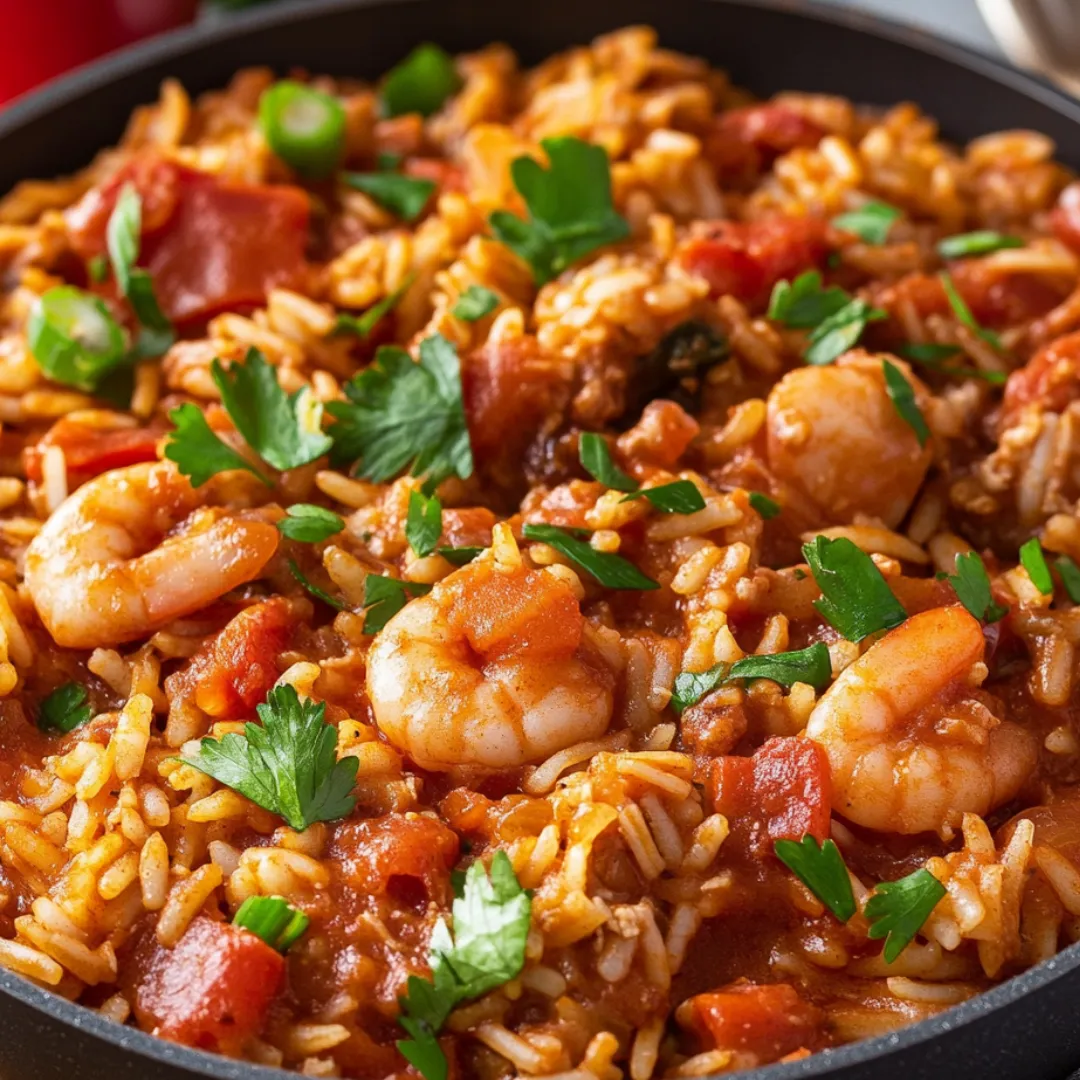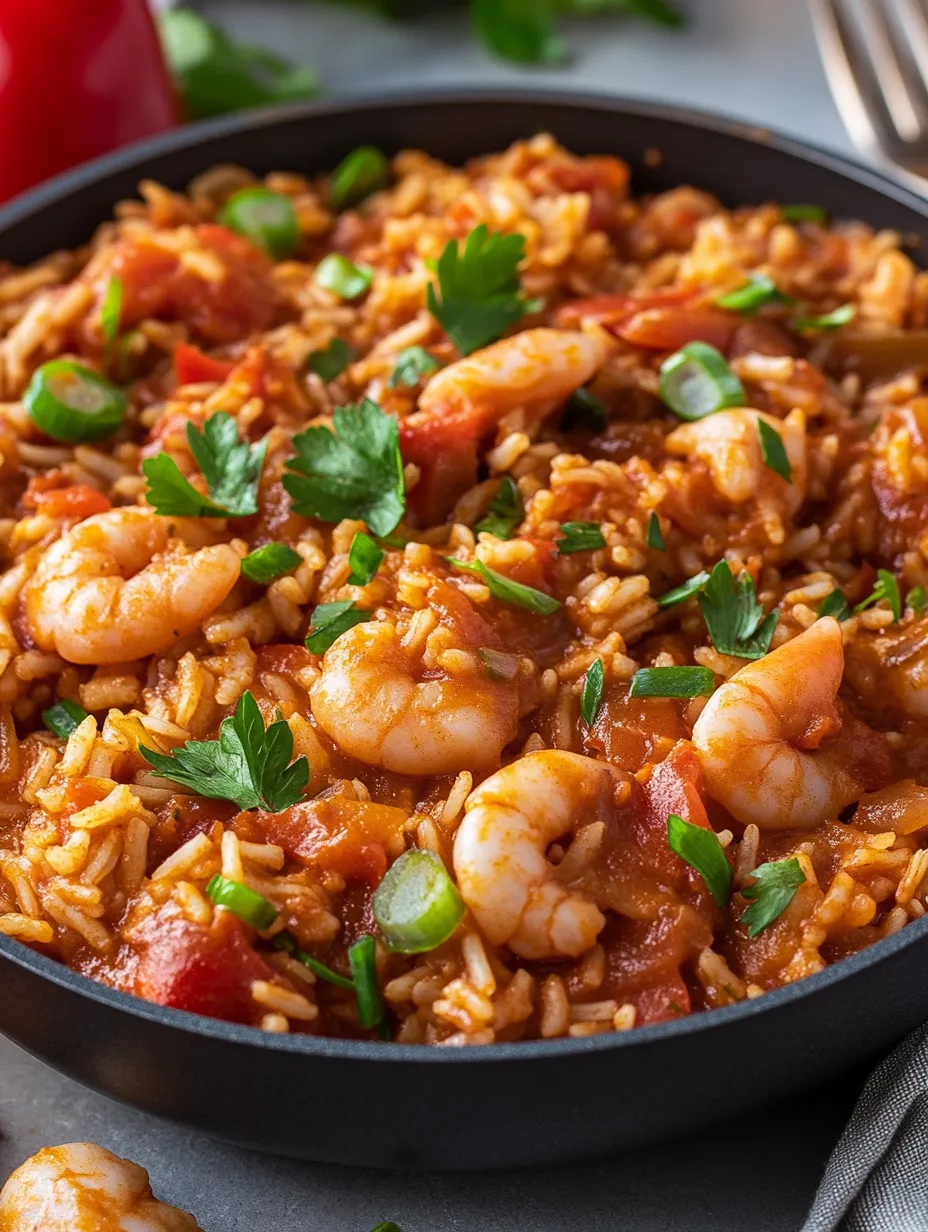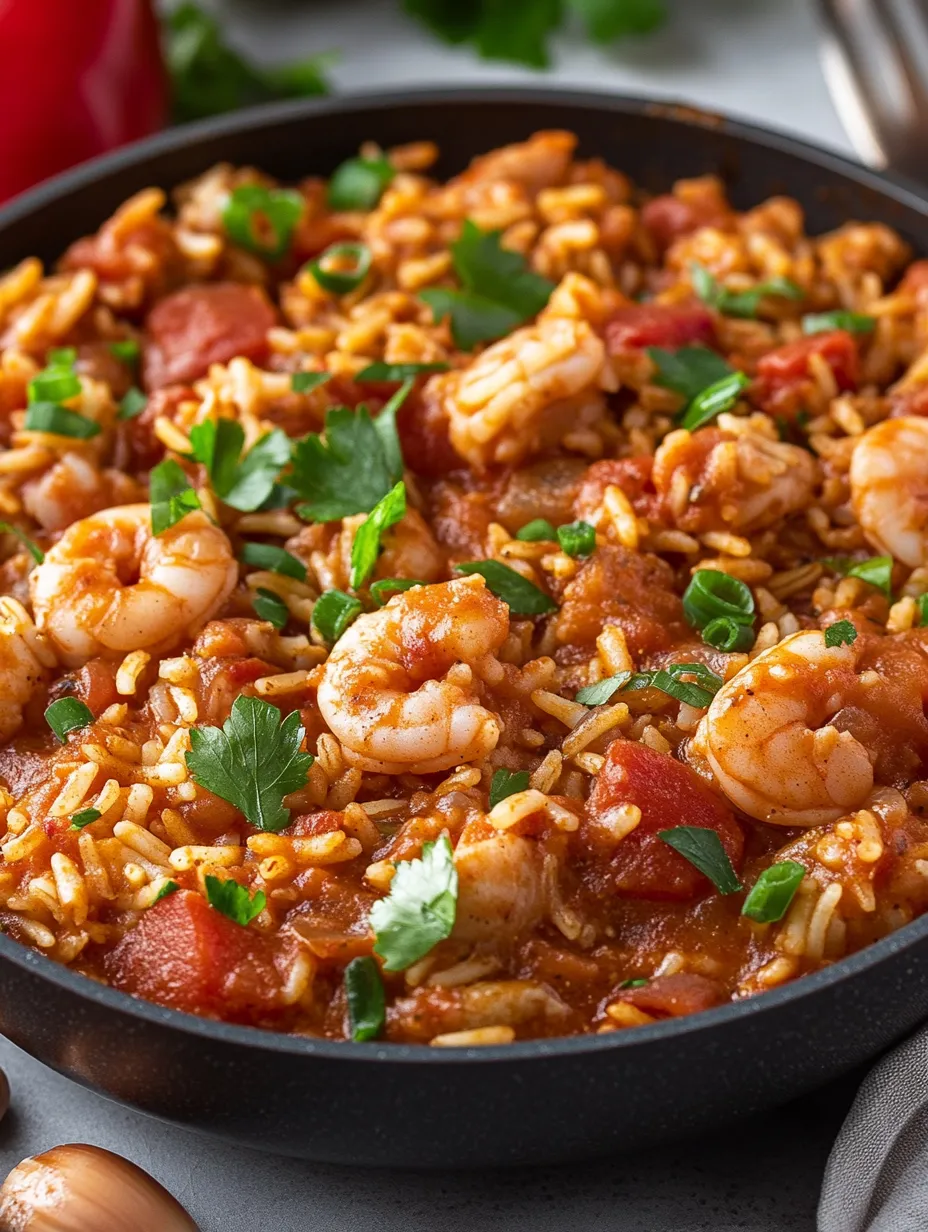 Pin it
Pin it
This Easy Jambalaya brings the soul-warming flavors of Louisiana to your dinner table without complicated techniques or hard-to-find ingredients. This one-pot wonder combines tender chicken, smoky sausage, and plump shrimp with aromatic vegetables and perfectly seasoned rice. Each spoonful delivers a harmonious blend of savory, spicy, and slightly sweet notes that transport you straight to New Orleans. Whether you're cooking for a crowd or preparing weeknight dinners, this adaptable recipe delivers maximum flavor with minimal effort, proving that authentic Southern comfort food doesn't have to be difficult to be delicious.
I discovered my love for jambalaya during a trip to New Orleans years ago, but was intimidated to recreate it at home until I developed this simplified version. What surprised me most was how my picky-eater husband, who normally avoids anything with bell peppers, devoured two heaping servings and claimed it was better than the restaurant version we'd tried! The secret is layering flavors gradually rather than dumping everything in at once. Now this has become our go-to dish whenever we're entertaining guests who expect to be impressed but I don't want to spend all day in the kitchen.
Ingredients You'll Need
- 1 pound Boneless, Skinless Chicken Thighs, diced: Thighs remain juicy through the cooking process; their higher fat content adds richness
- 8 ounces Andouille Sausage, sliced: Provides smoky depth and authentic Cajun flavor; substitute smoked kielbasa if unavailable
- ½ pound Medium Shrimp, peeled and deveined (optional): Adds sweet tenderness and coastal flair; thaw completely if using frozen
- 2 tablespoons Olive Oil: Used for sautéing the meats and vegetables; provides better flavor than vegetable oil
- 1 Large Onion, diced: Forms the aromatic base; yellow onions work best for their balanced sweetness
- 1 Green Bell Pepper, diced: Contributes essential flavor and color; fresh is significantly better than frozen
- 2 Celery Stalks, diced: Completes the 'holy trinity' of Cajun cooking; adds subtle flavor and texture
- 3 Garlic Cloves, minced: Infuses the dish with aromatic depth; fresh garlic provides much better flavor than powder
- 1 can (14.5 oz) Diced Tomatoes, undrained: Adds acidity, moisture, and subtle sweetness; fire-roasted variety enhances flavor
- 2 cups Chicken Broth: Forms the cooking liquid for the rice; use low-sodium to control salt levels
- 1½ cups Long-Grain White Rice, uncooked: Regular long-grain works best; avoid instant rice or short-grain varieties
- 2 teaspoons Paprika: Provides color and mild pepper flavor without excessive heat
- 1 teaspoon Dried Thyme: Adds earthy, herbaceous notes essential to Cajun cooking
- 1 teaspoon Dried Oregano: Contributes subtle complexity to the herb profile
- ½ teaspoon Cayenne Pepper (adjust to taste): Delivers the signature heat; start with less if sensitive to spice
- 1 teaspoon Smoked Paprika: Adds authentic smoky depth even if using milder sausage
- 2 Bay Leaves: Infuses the broth with subtle complexity; remember to remove before serving
- ½ cup Frozen Peas (optional): Adds color, sweetness, and nutritional value
- Salt and Black Pepper to taste: Enhances all other flavors; add gradually and taste as you go
- ¼ cup Fresh Parsley, chopped: Brightens the finished dish with color and fresh flavor
 Pin it
Pin it
Step-by-Step Cooking Instructions
- Brown Your Proteins Perfectly:
- Heat 2 tablespoons of olive oil in a large Dutch oven or heavy-bottomed pot over medium-high heat until shimmering but not smoking. Add the diced chicken thighs and sliced andouille sausage to the hot oil, arranging them in a single layer if possible. Allow them to cook undisturbed for 2-3 minutes to develop a golden-brown crust before stirring. Continue cooking for another 3-4 minutes until the chicken is no longer pink on the outside and the sausage has released some of its flavorful oils. This initial browning creates the foundation of flavor for your jambalaya through the Maillard reaction, which transforms proteins into complex, savory compounds that will infuse the entire dish.
- Build Your Aromatic Flavor Base:
- Add the diced onion, bell pepper, and celery to the pot with the browned meat. Stir everything together, using your spoon to scrape up any flavorful brown bits from the bottom of the pot. Cook this mixture for 5-6 minutes, stirring occasionally, until the vegetables have softened and the onions have become translucent. Next, add the minced garlic and cook for just 30-60 seconds until fragrant, being careful not to burn it as this would introduce bitterness. The vegetables will release moisture that helps deglaze the pot, incorporating all those concentrated meat flavors back into the dish while creating the classic aromatic foundation of Cajun cooking known as the 'holy trinity.'
- Incorporate Tomatoes and Spices:
- Pour in the undrained can of diced tomatoes and stir to combine. The acidity in the tomatoes will help tenderize the meat while adding moisture and a subtle sweetness. Next, add the paprika, thyme, oregano, cayenne pepper, smoked paprika, 1 teaspoon of salt, and ½ teaspoon of black pepper. Stir continuously for about 1 minute to toast the spices, which releases their essential oils and intensifies their flavors. This step is crucial for developing the signature jambalaya taste profile – the spices should become fragrant but not burnt. The tomatoes provide moisture that prevents the spices from scorching while allowing their flavors to bloom.
- Add Rice for Perfect Absorption:
- Add the uncooked long-grain rice to the pot and stir for 2-3 minutes, coating each grain with the flavorful mixture. This toasting step helps the rice maintain its integrity during cooking and prevents it from becoming mushy. The starch on the outside of the rice will begin to gelatinize slightly, which helps the grains remain separate while still absorbing the flavors of the broth. Make sure every grain of rice is well-coated with the tomato and spice mixture before proceeding to the next step – this ensures even cooking and flavor distribution throughout the finished dish.
- Simmer to Perfection:
- Pour in the chicken broth and add the bay leaves, stirring once to combine everything evenly. Bring the mixture to a boil, then immediately reduce the heat to low. Cover the pot with a tight-fitting lid and allow the jambalaya to simmer gently for 20-25 minutes without lifting the lid or stirring. The undisturbed cooking environment allows the rice to absorb the liquid and flavors evenly. After 20 minutes, check if the rice is tender and most of the liquid has been absorbed. If needed, cook for an additional 3-5 minutes. The ideal consistency should be moist but not soupy, with each grain of rice distinct yet tender.
- Add Finishing Touches:
- If you're including shrimp and frozen peas, now is the time to add them. Gently fold them into the hot jambalaya, replace the lid, and remove the pot from the heat. Let it stand for 5-7 minutes. The residual heat will cook the shrimp to perfect tenderness without making them rubbery, while warming the peas through. During this resting period, the flavors continue to meld and the texture of the dish improves as the rice absorbs any remaining liquid. This gentle finish ensures that delicate ingredients aren't overcooked while giving the entire dish time to reach its peak flavor and texture.
- Final Flavor Adjustments:
- Remove and discard the bay leaves. Fluff the jambalaya gently with a fork and taste for seasoning, adding more salt, pepper, or cayenne if needed. Sprinkle the freshly chopped parsley over the top just before serving. The parsley adds brightness both visually and in flavor, cutting through the richness of the dish with its fresh, herbaceous notes. Serve the jambalaya hot, straight from the pot for family-style dining, or portion it into bowls for individual servings. A few dashes of hot sauce on the side allow each person to customize the heat level to their preference.
I learned the importance of proper heat management with this dish through embarrassing trial and error. During my first attempt, I was impatient and kept the heat too high, resulting in rice that was burned on the bottom and undercooked on top. Now I'm religious about maintaining a gentle simmer and giving the rice its undisturbed cooking time. The difference is remarkable – perfectly tender rice with defined grains rather than a mushy or unevenly cooked mess. When my neighbor complained about inconsistent results with her jambalaya, I shared this heat management tip, and she was amazed at how much it improved her next batch.
Regional Variations
True jambalaya enthusiasts know there are two main regional styles: Creole and Cajun. This recipe leans toward the Creole version with its tomato base, which originated in New Orleans. For a more traditional Cajun style from rural Louisiana, omit the canned tomatoes and use an extra ½ cup of broth. The rice will take on a brown color from the meat and spices rather than the reddish hue of Creole jambalaya. Both styles are authentic and delicious – the choice depends on your personal preference or which region's cuisine you're trying to replicate.
Make-Ahead Strategies
This jambalaya actually improves with time as the flavors continue to meld. You can prepare it up to two days ahead and refrigerate in an airtight container. Reheat gently on the stovetop with a splash of broth or water to restore moisture. For meal prep, portion the cooled jambalaya into single-serving containers for quick lunches or dinners throughout the week. If freezing, omit the shrimp initially and add freshly cooked shrimp when reheating for the best texture. Frozen jambalaya remains delicious for up to three months when properly stored.
Serving Suggestions
While jambalaya is a complete meal on its own, traditional accompaniments enhance the experience. Serve with slices of crusty French bread for sopping up every bit of the flavorful sauce. A simple side salad with a light vinaigrette provides fresh contrast to the hearty main dish. For an authentic New Orleans experience, serve with a side of collard greens or okra. And of course, no jambalaya meal would be complete without some Louisiana-style hot sauce on the table for those who want to increase the heat level.
 Pin it
Pin it
Dietary Adaptations
This versatile recipe welcomes many modifications to suit dietary needs. For a gluten-free version, simply ensure your sausage contains no gluten fillers. Create a vegetarian jambalaya by omitting the meats and using vegetable broth, while adding kidney beans and additional vegetables like mushrooms and zucchini for substance. For a lower-carb option, reduce the rice by half and double the proteins and vegetables. Those watching sodium can use low-sodium broth and adjust the salt content to taste without sacrificing flavor.
I discovered a game-changing technique for this recipe completely by accident. One day while making jambalaya, I received an urgent phone call just after adding the rice and broth. By the time I returned, the pot had been simmering for nearly 25 minutes without my usual 'check' at the 15-minute mark. Instead of ruined dinner, I found perfectly cooked rice with distinct grains and incredible flavor development. This taught me that patience is truly a virtue with jambalaya – the less you fuss with it, the better it turns out. Sometimes the best cooking discoveries come from what seems like a mistake!
Frequently Asked Questions
- → Can I use brown rice instead of white rice?
- Yes, but you'll need to increase the cooking time to 45-50 minutes and may need to add an extra 1/2 cup of broth since brown rice absorbs more liquid.
- → What's the difference between jambalaya and gumbo?
- Jambalaya is a rice-based dish where all ingredients cook together. Gumbo is more of a stew served over rice, and it's thickened with a roux, okra, or filé powder.
- → Is jambalaya supposed to be soupy?
- No, jambalaya should be moist but not soupy. The rice should absorb most of the liquid during cooking, resulting in a consistency similar to paella.
- → Can I make this vegetarian?
- Yes, skip the meats and use vegetable broth. Add more bell peppers, mushrooms, and even beans or plant-based sausage for protein.
- → How spicy is this recipe?
- As written, it's mildly spicy. The heat comes mainly from the cayenne pepper and the type of sausage used. Adjust these elements to control the spice level.
